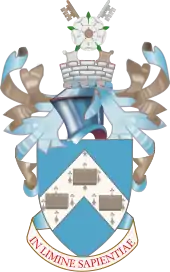King's Manor
The King's Manor is a Grade I listed building in York, England, and is part of the University of York. It lies on Exhibition Square, in the city centre.
.jpg.webp)
Location within York |
History
King's Manor was originally built to house the abbots of St Mary's Abbey, York.[1] The Abbot's house probably occupied the site since the eleventh century, but the earliest remains date from the fifteenth century. When the abbey was dissolved in 1539, Henry VIII instructed that it be the seat of the Council of the North.[1] It performed this role until the Council was abolished in 1641.[1] From 1667 to 1688, it was the residence of the Governor of York. During the Glorious Revolution of 1688, the Governor, Sir John Reresby, 2nd Baronet, remained loyal to the King, James II, but a party of armed men, led by Thomas Osborne, Earl of Danby, captured the Manor and the City of York, and held them for William of Orange. After 1688, the building was hired out to private tenants until the nineteenth century, when it was taken over and expanded by the Yorkshire School for the Blind.[1] For a detailed description of the history and architecture of the building, perhaps the best source is that contained in the RCHME Inventory of the City of York, Volume IV.[2]
Use by University of York
On the departure of the Blind School in 1958, the Manor was acquired by York City Council, who leased it to the University in 1963.[1] The main University later moved to the Heslington Campus. From 1966, the principal academic department to use the Manor was the Institute of Advanced Architectural Studies (IoAAS). [3] The IoAAS was a leading UK provider of mid-career education for architects and related professionals, specialising latterly in architectural conservation studies. The main public room of the Manor is the Huntingdon Room, used for courses and meetings. As well as the IoAAS, there were several other Departments in the King’s Manor, the main ones being the Centre for Medieval Studies, a Language Teaching centre and the Design Unit (an architectural practice, but part of the IoAAS). The building also housed six University staff flats. The Dining Room provided an important place for the meeting of ‘town and gown’, especially in the early years of the University. Following the closure of the IoAAS, the main occupant became the Department of Archaeology (including the Archaeology Data Service), plus the Centre for Medieval Studies and the Centre for Eighteenth Century Studies.[1]
See also
References
- Historic England. "King's Manor, York (58182)". PastScape. Retrieved 1 October 2013.
- "The King's Manor | British History Online". www.british-history.ac.uk. Retrieved 17 September 2018.
- "IoAAS courses description" (PDF). Retrieved 11 September 2018.
External links
| Wikimedia Commons has media related to King's Manor. |
